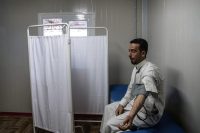
Dejen que la gente coma
En las peores condiciones imaginables —tras huracanes, terremotos, bombas y disparos— aparece lo mejor de la humanidad. No una vez, ni dos, sino siempre.
Las siete personas asesinadas en una misión de World Central Kitchen en Gaza el lunes eran lo mejor de la humanidad. No son anónimos: tienen rostro y nombre. No son trabajadores humanitarios genéricos ni daño colateral de la guerra.
Saifeddin Issam Ayad Abutaha, John Chapman, Jacob Flickinger, Zomi Frankcom, James Henderson, James Kirby y Damian Sobol arriesgaron todo en favor de la actividad más fundamentalmente humana: compartir nuestro alimento con los demás.
Junto a ellos serví en Ucrania, Turquía, Marruecos, las Bahamas, Indonesia, México, Gaza e Israel.… Seguir leyendo »














